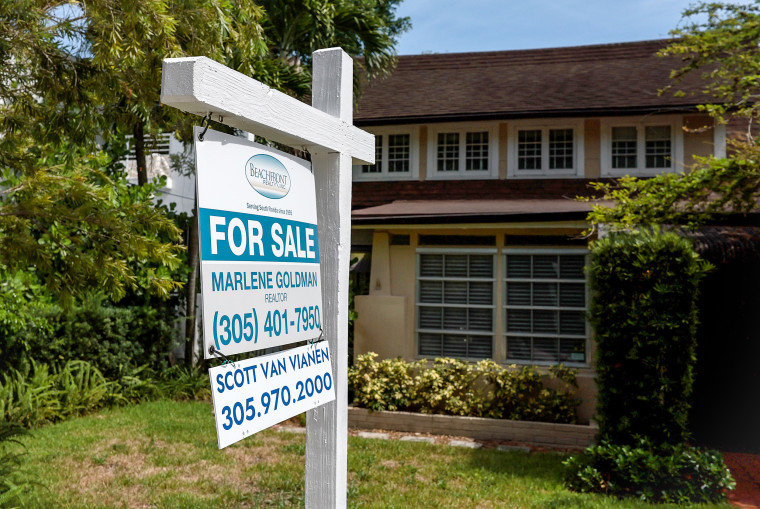Federal Reserve Chair Jerome Powell and members of his Federal Reserve Board might not be cruel and heartless people, but they are in the process of killing the American dream of home ownership for millions of families. As the central bank continues to aggressively raise interest rates in its battle to get inflation under control, the housing market is collateral damage. Sadly, it didn’t have to be this way.
After the Fed raised its benchmark rate on Wednesday for the seventh time this year, it’s likely the dynamic will only get worse. For every percentage point increase in mortgage rates, the number of households who can afford a $400,000 mortgage declines by 3 to 4 million, according to Freddie Mac, the federally sponsored enterprise that promotes home lending. Freddie Mac estimates that 15 million potential homebuyers have been priced out of the housing market this year because, for the first time in U.S. history, the average 30-year fixed-rate mortgage rate has more than doubled in a year’s time, from about 3% to more than 6%.
Had the Federal Reserve been more vigilant on its inflation watch, much of this pain could have been avoided.
As mortgage rates are rising faster — much faster — than home prices will drop, Americans who do still buy new homes will be digging deeper into their wallets, adding to the financial stress of high inflation. And more financial pressure may be in the pipeline for the growing number of buyers who are now opting for adjustable rate mortgages. Such mortgages make their payments lower in the short term, but they can easily adjust upward, often by 2% or more, several years down the road, making monthly installments intolerably expensive.
These financial pressures are coming after the Covid-19 relief program’s federal moratorium on foreclosures ended in July 2021. Since then, foreclosure filings have been ballooning, up 57% in November compared to the same month last year. Though for now, they are nowhere near levels hit during the housing crash of 2008.
Already the housing market, which accounts for nearly 18% of the U.S. economy, is in a serious recession, with home sales sinking and prices beginning to fall. With inflation now running at an annual rate of 7.1%, as measured by November’s Consumer Price Index, the Fed is trying to slow it through a process that economists call “demand destruction.” By raising interest rates, the central bank makes it more expensive to borrow and spend. As the most interest-sensitive sector of the economy, housing gets slammed.
It’s not just prospective homebuyers who are suffering the consequences of sharply higher mortgage rates. Homeowners are finding they can’t sell their homes for what they were worth just a few months ago. This is particularly troublesome for couples approaching retirement, such as neighbors of mine who are looking to downsize.
Three months ago, a home very comparable to theirs sold in our neighborhood for the impressive price of more than $1.3 million. But the couple recognize they are now selling into a declining market, so they listed their home for just under $1 million. It’s as if a chunk of their nest egg has suddenly been snatched from underneath them.
Sadly, had the Federal Reserve been more vigilant on its inflation watch, much of this pain could have been avoided. The Fed’s mandate is to maintain price stability while attempting to maximize employment, and among its primary tools is the Fed funds rate. It’s the cost of borrowing for banks. They, of course, pass that cost onto their customers, while also tying their mortgage rates to Treasury bond yields, which have shot up this year, reflecting rising inflation expectations.
Wednesday’s rate increase caps the most intensive year of central bank inflation fighting since 1981, when interest rates soared to double digits in a similar campaign led by Paul Volcker, the Fed chair who slayed that bout of inflation but in the process pushed the economy into a severe double-dip recession.
In the first half of last year, inflation was accelerating rapidly, increasing many times over. By June the Consumer Price Index was clocking in at an annual rate of 5.4%. Yet Powell argued the pickup in inflation was transitory. So, Powell and his Fed governors hung on to their new policy, introduced in 2020, that permitted inflation to run above the Fed’s traditional target of 2%.
The Fed at the time was far more concerned with pumping up an economy battered by Covid than preventing a pickup in inflation. In fact, the central bank was injecting tens of billions of dollars into the financial system every month to grease the economy’s wheels.
As it turned out, the central bank was helping to fuel the inflation it was supposed to be preventing. The Fed’s foot was pressing on the economic accelerator far too long as it persisted in extraordinary efforts to prevent the country from falling into a pandemic-induced recession, and it failed to hit the brakes in the summer of 2021, when inflation began to accelerate.
A humbled Powell would later concede it was time to “retire” his description of inflation as transitory and admitted, “I think we understand better how little we understand about inflation.” Now the Fed is trying to compensate for its mistakes by raising interest rates at the fastest pace in four decades.
As the housing market slumps, the Federal Reserve is fighting a battle not only to curb inflation, but to restore its reputation as an inflation fighter. Sadly, this is a necessary evil because our country’s economic stability requires that we keep inflation under control and that’s the Fed’s job. But if the nation’s central bankers had more foresight, it would not be so hard today for millions of people to achieve home ownership and a secure retirement.
